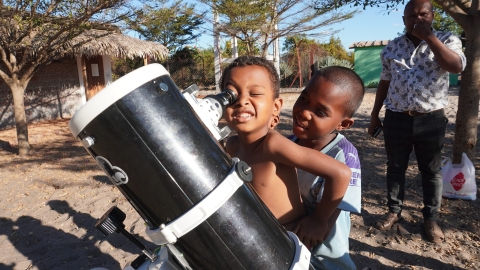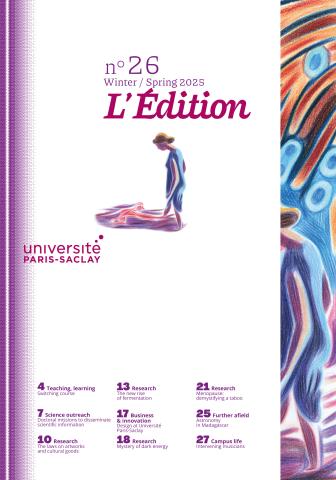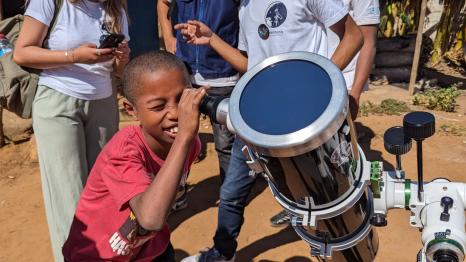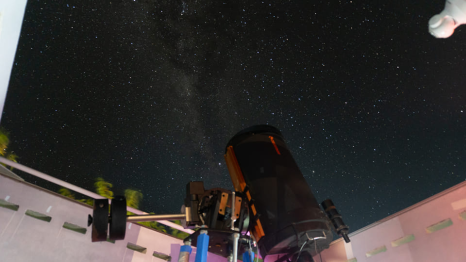
Developing astronomy under Madagascar's starry skies
This article was originally published in L'Édition n°26.
In Madagascar, the Haikintana association has been working with French scientists, including some from Université Paris-Saclay, for several years to develop astronomy and space science across the island. In 2022, this initiative led to the construction of Madagascar's first robotic astronomical observatory.
What do the asteroid Besely, the star Rapeto and the planet Trimobe have incommon? All three of these celestial objects have names of Malagasy origin: Besely refers to a village in north-west Madagascar, while Rapeto and Trimobe are characters from the country's best knownlegends. However, these celestial bodies are not just the first to bear such names; they also illustrate a remarkable project to develop astronomy in Madagascar, spearheaded by the Haikintana association and supported by French researchers, including SylvainBouley, a planetary scientist from the Geosciences Paris-Saclay laboratory (GEOPS - Univ. Paris-Saclay/CNRS) and President of the French Astronomical Society (Société Astronomique de France - SAF).
"I've been working to develop astronomy inAfrica for some twenty years now," explains the researcher. "Over there, the sky is magnificent, there's virtually no pollution, but there are very few observatories and astronomy clubs. So the idea is to make astronomy accessible to as many people as possible." Sylvain Bouley remembers that his first encounter with Madagascar came about "somewhat by chance" in 2019.
That year, Sylvain Bouley organised “On the moon again”, a massive event to celebrate the fiftieth anniversary of the first Moon landing. Astronomers from all over the world were invited to take their telescopes into the streets and show passers-by the Earth's satellite. "It was a great success. There were over 1,300 events in seventy countries," he recalls. "We also organised a video competition to win a telescope." That was when the planetary scientist crossed paths with Mializo Razanakoto, competition winner and founder of Haikintana.
An astronomical association born of a lunar eclipse
"Haikintana's aim is to popularise astronomy and space sciences in Madagascar through fun activities, information workshops, observation sessions, outreach events and educational projects," she explains. Passionate about astronomy since she was a child, the young woman sowed in 2015 the seeds of Haikintana with a simple Facebook page launched on the occasion of a lunar eclipse.
"I'd seen a lot of false rumours and superstitious comments about the lunar eclipse on social media. This frustrated me and I wanted to create a Facebook page to counter balance such posts and explain this type of phenomenon." A year later, the founder, joined by other enthusiasts she had met during a travelling planetarium project, organised her first activities with the support of the Malagasy Association for the Promotion of Science (AMPS). This was the starting point for a great adventure for the Haikintana association which became an official body in 2018.
"In 2019, we took part in the centenary celebration of the International Astronomical Union (IAU) and the campaign to name an exoplanet and its star," the famous planet Trimobe and its star Rapeto, recounts Mializo Razanakoto. Then came the “On the moon again” event and the meeting with Sylvain Bouley. "He was very interested in what we were doing in Madagascar, and we both had this idea of building an observatory that would be used to raise public awareness of astronomy and serve as observational equipment for students."
Madagascar's first robotic observatory
The idea eventually became reality with the help of Charles Gassot, a former French film producer and founder of the NGO Écoles du monde (World Schools), which works to improve living conditions in the bush in Madagascar. In 2022, an astronomical observatory was commissionedon the Besely campus, created by the NGO, 40 kilometres from the town of Mahajanga, along with a school, canteen, infirmary and other facilities. "Building such an observatory is not easy, because it requires electricity, an Internet connection and a certain amount of logistics. The Besely campus was therefore the ideal location," explains Mializo Razanakoto.
The observatory, equipped with a thirty-five centimetre telescope and installed under a sliding roof, is notable for being roboticand connected to remote control software. "This means it can be controlled and operated from anywhere. We wanted it to be accessible to as many people as possible," explains the planetary scientist. Consequently, the observatory is accessible to the Besely community, but also to amateur and professional astronomers in Madagascar, Africa and France.
"The skies of the southern hemisphere are notthe same as those of the northern hemisphere. The observatory provides a base for observing asteroids, comets and many other objects not accessible from France." In September 2022, Besely's telescope was on hand to follow NASA's DART mission to hit an asteroid. "This observatory is a real way of continuing to develop astronomy in Madagascar," enthuses the founder of Haikintana, which is continuing to expandits activities through partnerships forged in Madagascar and France.
A year of celebrations for a memorable anniversary
In July 2024, the association organised its second annual astronomy festival in Mahajanga: three days of presentations in schools, lectures and observations ofthe sky. "We took advantage of the event to donate a telescope to the newly-formed Mahajanga Astronomy Club," explains Sylvain Bouley. Creating astronomy clubs to spread the passion for the sky is one of the key priorities of Haikintana, which will be celebrating its tenth anniversary this year with a number of projects.
"We've planned a year of celebrations, until May 2026, with observation sessions, photo exhibitions, courses for our members, afestival to be held in four different towns, and more," reveals Mializo Razanakoto. "In Besely, we're also going to organise a school for African astronomers, so that they can learn how to use the observatory and operate it remotely from their own countries," addsSylvain Bouley. With so many projectsand thousands of eyes turned towards Madagascar's starry skies, the future of astronomy is bright in Madagascar.
Learn more :

This article was originally published in L'Édition n°26.
Find out more about the journal in digital version here.
For more articles and topics, subscribe to L'Édition and receive future issues:


